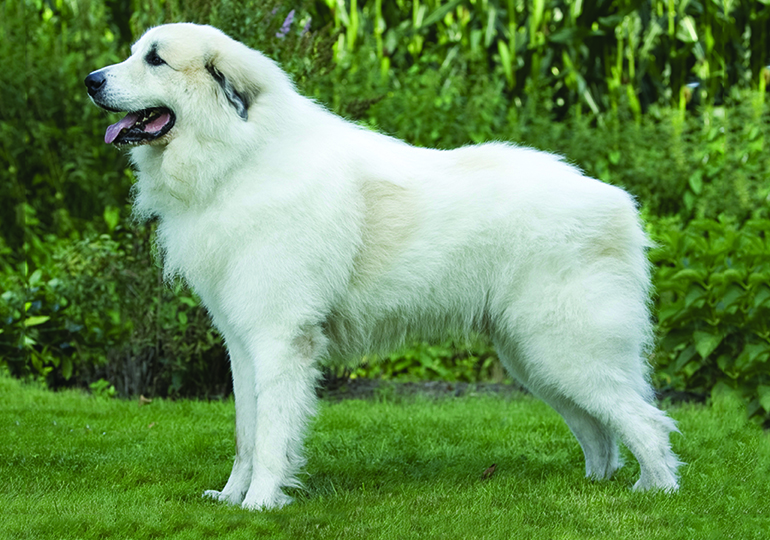Pyrenean Mountain Dog
Breed Details
Size:
Exercise Requirements:
Grooming Requirements:
40-50 Kg (Approx)
10-12 years (Approx)

Appearance
The Pyrenean Mountain Dog, known as the Great Pyrenees in North America, is a large breed of dog used as a livestock guardian dog. It should not be confused with the Pyrenean Mastiff.
A powerful and imposing dog with a certain elegance. Great size, strongly built but not cumbersome. Well balanced and of noble bearing.
The weather resistant double coat consists of a long, flat, thick, outer coat of coarse hair, straight or slightly undulating, and lying over a dense, fine, woolly undercoat. The coat is more profuse about the neck and shoulders where it forms a ruff or mane, which is more pronounced in males, so that it may fend off wolf attacks. The longer hair on the tail forms a plume. There is also feathering along the back of the front legs and along the back of the thighs, giving a "pantaloon" effect. The hair on the face and ears is both shorter and of finer texture.
The main coat colour is white and can have varying shades of grey, red (rust), or tan around the face (including a full face mask), ears and sometimes on the body and tail. As Pyrenean Mountain Dogs mature, their coats grow thicker and the longer, coloured hair of the coat often fades. Sometimes a little light tan or lemon will appear later in life around the ears and face. Being a double-coated breed, the undercoat can also have colour and the skin as well. The colour of the nose and on the eye rims should be jet black. Grey or tan markings that remain lend the French name, "blaireau", (badger) which is a similar grizzled mixture colour seen in the European badger. More recently, any colour is correctly termed "Badger" or "Blaireau".
History
The Pyrenean Mountain Dog is a very old breed that has been used for hundreds of years by shepherds, including those of the Basque people, who inhabit parts of the region in and around the Pyrenees Mountains of southern France and northern Spain (specifically Aragon and Navarre).
One of the first descriptions of the breed dates from 1407, Fray Miguel Agustín, "prior" of the Temple who lived between 1560 and 1630, published in 1617 in Catalan (the first edition appeared in Spanish in 1622), "The wool cattle dogs should not must be so big or so heavy as those of the guard of the house, but strong and sturdy, lightweight and ready to combat and fight and for run, because they have to make saves and guard against wolves and hunt them down if those take a cattle... These should be white, so that the shepherd can easily see when these run after the wolf and know them in the evening and the morning."
From 1675 the breed was a favourite of The Grand Dauphin and other members of the French aristocracy.
As late as 1874 the breed was not completely standardised in appearance, with two major sub-types recorded, the Western and the Eastern.
They are related to several other large white European livestock guardian dogs (LGD), including the Italian Maremma Sheepdog, Kuvasz (Hungary), Akbash Dog (Turkey) and Polish Tatra or Polski Owczarek Podhalański, and somewhat less closely to the Newfoundland and St. Bernard.
According to the Great Pyrenees Club of America, the Pyrenean Mountain Dog is naturally nocturnal and aggressive with any predators that may harm its flock. However, the breed can typically be trusted with small, young, and helpless animals of any kind due to its natural guardian instinct.
Temperament
In nature, the Pyrenean Mountain Dog is confident, gentle (especially with children), and affectionate. While territorial and protective of its flock or family when necessary, its general demeanor is of composure and patience and loyalty. It is a strong willed, independent and reserved breed. It is also attentive, quite fearless and loyal to its duties. The breed's size makes it an imposing guardian. A dog of this breed will patrol its perimeter and may wander away if left off its leash in an unenclosed space. The Pyrenean Mountain Dog protects its flock by barking, and being nocturnal, tends to bark at night unless trained against such behaviour.
The Pyrenean Mountain Dog can be slow to learn new commands, slow to obey, and somewhat stubborn to train. It is wary of strangers if the person is not allowed in the house, but will settle down if the owner of the dog seems comfortable with the stranger. This dog was originally bred to be a livestock guard dog, and can still be found doing that job on farms and ranches.
When kept as a house pet, the breed's coat needs brushing once or twice a month. The breed needs moderate exercise but tends to be somewhat lazy, especially in warm weather. They particularly enjoy cold weather and snow. Like similar breeds, some Pyrenean Mountain Dogs tend to drool, especially with exercise, heat or stress. However, this is not on a Beethoven like scale, and generally they are not droolers. The breed need to have their nails clipped often to avoid damage. This breed also needs to have their teeth and ears cleaned regularly to prevent infection.
Care/Grooming
When kept as a house pet, the breed's coat needs brushing once or twice a month. The breed needs moderate exercise but tends to be somewhat lazy, especially in warm weather. They particularly enjoy cold weather and snow. Like similar breeds, some Pyrenean Mountain Dogs tend to drool, especially with exercise, heat or stress. However, this is not on a Beethoven like scale, and generally they are not droolers. The breed need to have their nails clipped often to avoid damage. This breed also needs to have their teeth and ears cleaned regularly to prevent infection.
Breeders
Currently no Breeders in SA for this Breed

